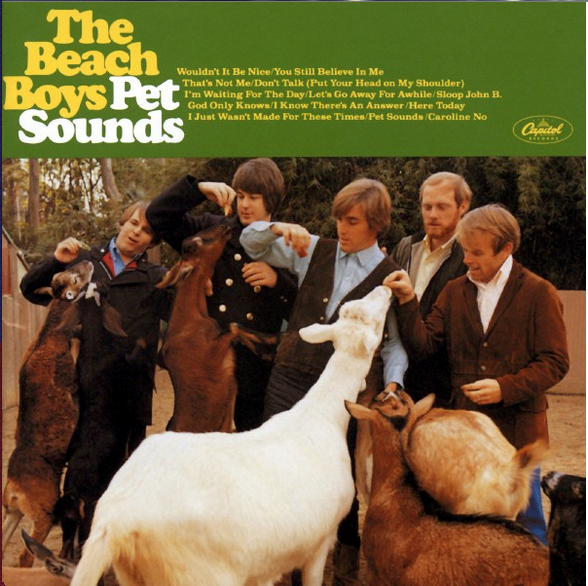Classic Albums Review: Pet Sounds

February 15, 2015
With music, which has been one of the central facets of culture for hundreds of years, the artist(s) involved have the unique task and opportunity of displaying something in a purely audio format. Pet Sounds, a studio album by the Beach Boys released on May 16, 1966, is a magnificent example of said artists taking full advantage of their abilities and creating such an incredible environment for the listener that it has achieved critical and commercial success since it was originally released. Apart from being a turning point in the musical career of Brian Wilson, who wrote nearly all of the album’s material himself, Pet Sounds was a watershed moment in the world of popular music; it advanced the methods of studio production and recording, was one of the first ever rock concept albums, and is one of the first mainstream albums to feature characteristics of the psychedelic rock genre. But, even with all of these advancements which make up a fair amount of the praise directed at Pet Sounds, which may or may not affect your opinion on the album as a music lover, the basic content of the album (i.e. its lyrics, themes, and instrumentation) are worthy of great praise as well.
Perhaps the most impactful of factors that sets Pet Sounds aside and above of other albums is its innovative and distinct studio production. Brian Wilson, who as I mentioned earlier did practically all of the writing and composition for Pet Sounds, was heavily influenced by the production techniques of Phil Spector. Spector’s “Wall of Sound” method, which is characterized by additional acoustic and electric instrumentation as well as a distinct echoing sound, was used and expanded upon by Wilson when he was producing Pet Sounds. What Wilson would do during the production of Pet Sounds is he would record backing tracks, which incorporated the typical instruments of a rock band (bass, electric guitar, drums) as well as a variety of ‘unusual’ instruments and session musicians. Then Wilson would record the vocals over the backing tracks, making it so that each of the vocalists were perfectly in key to create flawless harmonies. All the while, Wilson would use all the tools at his disposal in the studio, mixing in reverberation, tape delay, and even adding additional instrumental tracks (e.g. doubling the electric bass with an acoustic upright bass). The reason I go into such detail with the album’s production is that there was simply nothing like what Wilson was doing at that point in the musical world. The meticulous process and nine months of recording and production is truly what makes Pet Sounds a magnificent album on its own – regardless of its influences on other artists and genres.
Now, with any great piece of music, there’s bound to be some other musicians who drew inspiration from Pet Sounds. The list of individual artists would be too extensive for a mere review, but the type of music that came from albums like Pet Sounds must be considered when judging the quality of any album. With Brian Wilson’s years-long consumption of psychedelic drugs, he constantly tried to incorporate the feeling of psychedelia in his music. He managed to accomplish this psychedelic feel in Pet Sounds primarily by his incorporation of various instruments as well as some of the introverted lyrics within the album. Though other contemporary artists had started to use elements of psychedelia in their music (namely The Beatles and Bob Dylan), the vast range of instruments have been the primary focus of critics and music historians when considering the psychedelic parts of Pet Sounds.
While psychedelic rock may not be the strongest point in terms of Pet Sounds revolutionizing popular music of the 1960s, the fact that it was one of the first concept albums in rock most certainly is a strong point. But what exactly is a concept album? By definition, it is an album that has a unifying lyrical/musical theme or conveys a story. While The Who might’ve made concept albums albums even more popular with later albums such as Tommy (1969) and Quadrophenia (1973) (two albums which brought about the term ‘rock opera’), Pet Sounds came first in the realm of rock concept albums. Throughout the album, there is a consistent theme relating to relationships as well as the consistency in musical style.
However, there is one criticism which pertains to this consistent lyrical theme. The whole boy-girl relationship lyrical theme was omnipresent even fifty years ago. So, considering that, it is fair to find some fault with this overplayed theme – even though the theme of love and relationships is one of the central themes in all of art. But, mind you, this isn’t the only type of lyrics found in Pet Sounds. Some songs, like “That’s Not Me” and “I Just Wasn’t Made For These Days”, show the more introverted nature of Brian Wilson as an artist and as a person.
All things considered, there is very little criticism to be found from a purely objective point of view when regarding Pet Sounds. With its unique and innovative style, quality, and influences on the world of popular music as a whole, Pet Sounds is a must for anyone who enjoys the rock genre or has any appreciation for music production in general. And if you really are too tired of love as a lyrical theme, consider this: sometimes the music behind the lyrics is much more important and significant than the lyrics themselves. And, I think it’s fair to say at this point, the music of Pet Sounds far outweighs any overused lyrical styles that may be found.